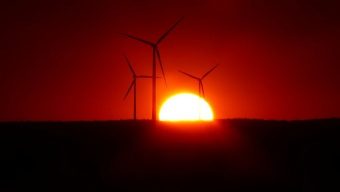
At the GreenBiz Verge Honolulu last week (formally the Asia Pacific Clean Energy Summit), I had the opportunity to connect with the renewables and sustainability community from across the state (and beyond). The event ‘welcomes those seeking to seize the renewable energy opportunity’ and the diverse crowd included government, military, local businesses, international companies, startups, and more.
On the first day, Hawaii Governor David Ige gave a talk about the current successes and the future opportunities for renewable capacity for the state. And as with most things here in the islands, it’s a pretty sunny situation.
Gov. Ige made headlines recently for signing legislation that made Hawaii the first US state to agree to the Paris Climate Accord after President Trump pulled the US out of the agreement. As reported by NPR, “the law commits the state to reducing greenhouse gas emissions in order to align with the principles and goals of the Paris Agreement.”
Needless to say, the Governor received a pretty warm welcome from this climate-focused crowd.
And he continued to prove that Hawaii is one of the leaders in climate change action by citing multiple state projects that ensures Hawaii is on track to reach 100% renewables by 2050, one of the most progressive renewable action plans in the country.
According to documents I reviewed from HECO (the state utility), Hawaii is currently at 26% renewables, and on track to 48% by 2020, and 67% by 2030.
This is a state average, since different islands have such different needs and abilities — Oahu has the highest population and most demand, while Molokai (part of Maui County with about 7,000 residents), is perhaps going to be the first to reach 100% renewables by 2020. Gov. Ige stated that the current island renewable capacity rates are 54% on the Big Island, 42% on Kauai, and 37% on Maui.
Ige shared an exciting list of improvements, innovation, and accomplishments across the counties (Honolulu, Hawaii, Kauai, Maui, which includes the islands of Molokai and Lanai).
The Hawaii Department of Transportation has undergone significant efficiency projects at the airports on Kauai, Maui, Oahu, and the Big Island. The DOT reports that guaranteed energy savings is more than $606 million over a 15-year period with the addition of this second phase, started in May 2017. Efficiency measures include replacing almost 50,000 florescent lamps with LEDs, adding trim to LED fixtures, and installing 15,683 photovoltaic roof-mounted panels, for a total of 5.3 megawatts at Honolulu International Airport alone. In total it will amount to nearly 8 megawatts of energy savings and power generation.
In 2016 Hawaii had a record heat wave, and this was particularly challenging to schools. Many of Hawaii’s schools are aged, and don’t have a infrastructure to support air conditioning or fans. This left classrooms as hot as 110°. The Hawaii Department of Education worked with the Legislature to bring ‘Cool School’ efforts to help the schools.
This $100 million project includes air conditioning (which includes PV-powered AC), passive cooling (using heat-reflective paint, night-time vents, insulation, ceiling fans), and electrical efficiencies (to keeps costs low as AC is added).
The state brings in about $5-6 billion worth of fossil fuels each year. But reducing this need is a priority for the state, and in March Gov. Ige signed legislation for energy efficiency for new buildings that is slated to save $14 billion in energy costs over the next 20 years.
Blue Planet Foundation reports that the new building energy codes will apply to all state construction, until two years in when counties will be required to take action too. This replaces “decade-old building efficiency rules.” Additionally, Hawaii Energy has been ‘aggressively’ promoting rebates and working with local companies to increase adoption of energy efficiency initiatives, delivering 1.2 million kW of savings over the lifetime of equipment.
There are so many good things to watch as Hawaii moves towards its progressive and aggressive clean energy goals, and here’s hoping it inspires other states to improve their own energy goals.
Source: cleantechnica.com

